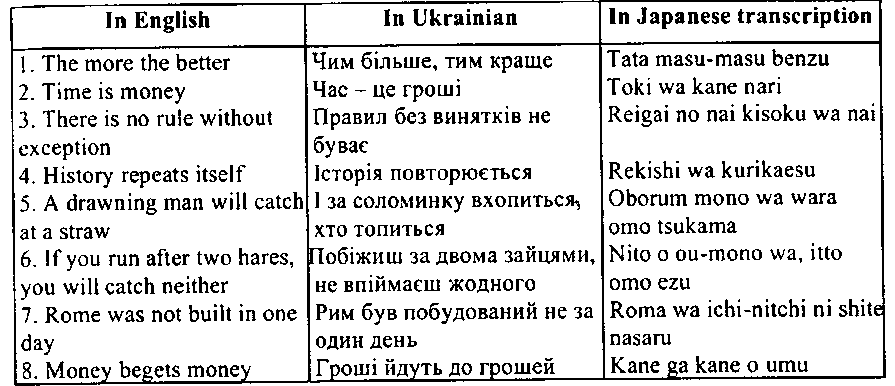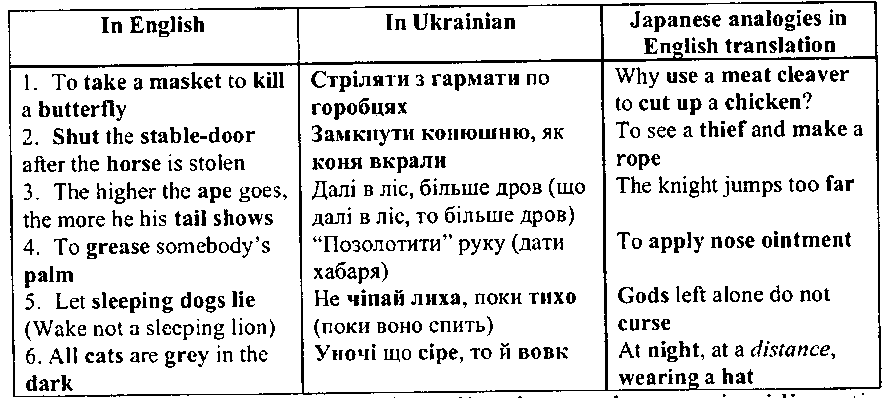
4. Classification of phraseological units and their structural types.
There are different classifications of ph.u. from the synchronic point of view based on different approaches: semantic (V.V.Vinogradov), functional (A.I. Smirnitsky), contextual (H.N.Amosova).
V.V. Vinogradov's classification is considered to be the oldest and the most popular. It is based on the degree of idiomaticity and divides phraseological units into 3 groups, the first including the most idiomatic.
Phraseological Units



Phraseological Phraseological Phraseological
fusions unities collocations
Examples given below are organized according to the scale of idiomaticity.
Fusions: red tape – bureaucracy; heavy father – a serious part in a theatrical play; to spill the beans – to tell a secret.
Unities: a lame duck, a sacred cow, to show one's teeth, to see through rose-coloured spectacles.
Collocations: bad (awful) mistake, to take fancy (liking), to take (have) tea.
It can be clearly seen that the third group is made up of words possessing special lexical valency.
In A.V. Kunin's classification ph.u. are divided into 3 classes.
1. Idioms, or idiomatic expressions, are set expressions, with fully or partially transferred meanings, e.g., to show the white feather, an odd (queer) fish.
2. Semi-idioms have both literal and figurative meanings (literal meaning is either professional or technical), e.g., chain reaction, to lay down one's arms.
3. Phraseomatic units are set expressions with literal but complex meanings (the meaning is phraseomatically bound), e.g., to raise one's eyebrows, to pay attention (a visit), to clean one's fits (teeth), at the best.
The structural types of ph.u. are as follows.
1. Nominal phrases, e.g., a bit (piece) of one's mind, hot dog, Tom, Dick and Harry, the Trojan horse, the sword of Damocles; троянський кінь, дамоклів меч;
2. Adjectival phrases, e.g., as good as gold, as pretty as a picture, more dead than alive.
3. Verbal phrases, e.g., kick two birds with one stone, to clone (abut) one's eyes to smth, to have one's heart in one's mouth, to take the bull by the horns; брати бика за роги, пекти раків.
4. Adverbial phrases, e.g., from head to heals, in a twinkle of an eye, as quick as a flash, at (long) last, by and again, tit for tat; no всіх усюдах, тут і там, скрізь і всюди
5. Parenthetical phrases, e.g. by Jeorge! by Jove! my aunt!
6. Introductory phrases, e.g., after all, as a matter of fact.
7. Phrases with the structure of a sentence: a) sayings, e.g., never say die, all one's geese are swans; b) proverbs, e.g., every cloud has a silver lining, birds of a feather fly together.
These equivalents are as follows:

Some of the above-given stable and idiomatic expressions are undoubtedly direct borrowings from the European languages. The first and most evident of them is, of course, Rome was not built in one day, time is money, if you run after two hares you will catch neither and- some others.
Most of semantic correspondences in English and Ukrainian are also genuine or approximate analogies. This can be seen from the following few examples presenting the overwhelming majority of analogies as compared with the correlated number of the few near and absolute equivalents that were found in the above-named dictionary 6f Japanese idiomatic and stable expressions. Here are some of them:

As could be seen from the above listed examples, genuine idiomatic analogies even in genealogically not akin languages are semantically more transparent than the approximate phraseological/ idiomatic analogies. This can be seen from the so-called Japanese idiomatic expressions listed under number 1, 2,5 and 6. Thus, №1 Why use a meat cleaver to cut up a chicken? corresponds to the English To take a musket to kill a butterfly or to the Ukrainian стріляти з гармати по горобцях. Similarly in the Japanese No 2: to see a thief and make a rope which corresponds to the English to shut the stable-door after the horse is stolen and to the Ukrainian замкнути конюшню, як коня вкрали and others.
Approximate analogies, naturally, are still more obscure due to their componential parts/ images which are mostly very different in non-related/far distant, as in case of the Japanese languages. Sometimes they are hardly recognizable for the Europeans in general. Cf. for example, the one listed under №3: The knight jumps too far that corresponds to the English Let sleeping dogs lie and to the Ukrainian idiom He чіпай лихо, доки тихо. Similarly in № 4: To apply nose ointment which corresponds to the English To grease somebody’s palm and in Ukrainian "позолотити руку" (дати хабаря).
Therefore, typologically relevant universal idiomatic expressions may presumably be found only among the group/class of idiomatic near equivalents and among the so-called genuine and approximate idiomatic analogies, which are stable expressions having different componential parts/images but a similar/analogous lexical meaning.
